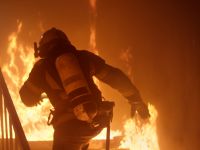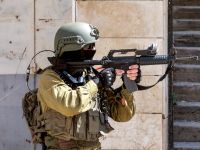As U.S. authorities call off the search for the bodies of Royal Saudi Air Force officer Major Ambarak S. Al-Ghamdi and his six American comrades in the Gulf of Mexico, experts have come to the conclusion that the men were killed in an inexplicable head-on collision between their two jets.
Major Al-Ghamdi, a flight instructor, flew out over the Gulf of Mexico on a training mission last Wednesday. The major and six others (all Americans) were aboard two U.S. Navy T-39 Sabreliner training jets. These aircraft are medium sized, twin-engine jets specially equipped to train flight crews in navigation and in the use of specialized electronics in flight.
The aircraft belonged to Training Squadron 86, a unit that instructs aircrews for U.S. and international armed forces. The Royal Saudi Air Force trains officers for its advanced new F-15S strike fighters at the unit.
The accident occurred around 3:00PM Wednesday. Harry White, a spokesman for the Naval Air Station in Pensacola, where the planes were based, told reporters that "They suddenly disappeared from our radar," and added "There was no distress call."
Flack Logan, an senior American Navy fighter pilot who commanded an aircraft carrier used to train pilots at the Naval Air Station from which the two doomed jets took off, explained to the St. Petersburg Times what had probably happened.
Mr. Logan assumed that the two aircraft had been training on "intercept geometry", in which student aircrews learn how to use radar to intercept enemy aircraft in the air. He explained that in the exercise, trainee officers on board one aircraft try to intercept the other. The exercise begins with both planes flying towards each other over the ocean, and once they pass each other the trainee aircraft turns and chases the target aircraft.
In order to avoid any chance of collision, the two aircraft are supposed to fly past each other at very different heights, and three or more miles to each other’s side. However, the sudden disappearance of both aircraft at the same time, with no emergency transmissions, has lead Logan and other experts to conclude that the only possibility was for the two aircraft to have struck each other head-on.
How such a catastrophe could have happened is a complete mystery. The two aircraft were flying in bright sunshine at mid-day. They were being piloted by two experienced pilots, retired former military aviators who were flying as contracted employees. The aircraft belong to Training Squadron 86, a unit that specializes specifically in this type of training, and which has recently won an award for its outstanding safety record having carried out over 330,000 flight hours without incident.
Upon reports of the disappearance of the two aircrafts, United States Navy and Coast Guard helicopters, aircraft and ships sped to the scene of the incident, 40 miles away from the Navy Base that the two planes had departed from. The searchers found only small bits of debris, and no survivors or bodies. Barely a day later, American officials called off the search, leaving the sudden disappearance of the seven men a mystery that is likely to remain unanswered. (www.albawaba.com)
T-39 Photo: VT-86, U.S. Navy









